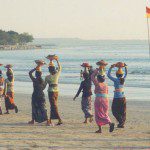Last month I shared two wonderful guest posts by researchers looking into race in American Buddhism (“Race Matters…” and “The Dukkha of Racism…“). I also noted the change, which occurred early in 2015, of the blog’s title from the singular “American Buddhist Perspective” to plural “Perspectives” in recognition that more perspectives than my own were being shared here and as an aspiration that this growth and diversity continues to flourish. Today I’m honored to share an interview that has been many months in the making – delayed by my travels and work responsibilities – which is almost certain to widen the perspective of readers here, dealing with issues around race, but more importantly feminism and intersectionality in our contemporary global Buddhist community.
Can you tell me who/what the Tibetan Feminist Collective is? How long has the collective been around and what brought you together?
The group is comprised entirely of young Tibetan women from India to the US. There are currently four of us – Kaysang, Choetso, Ngawang, and myself, but we’ve had other members before when we first got started and were trying to figure out what this space would look like. We are actually relatively new, having just formed last year. We are essentially a multimedia platform, using online spaces, technology, and new media tools to provide a platform for Tibetan women to promote and center our own narratives. There had been a lot of discussions in informal online forums for a while, and the Tibetan Feminist Collective just sort of grew organically into a manifestation of this growing consciousness among Tibetan women after years of being socially conditioned into not challenging patriarchal norms and attitudes in our culture/society (both in Tibet and in exile).
I first came across the Tibetan Feminist Collective last fall when the Dalai Lama was attacked on a popular feminist website for his comments about women and beauty. The article (“Yes, the Dalai Lama Is Still A Feminist …“
) fired back, arguing in part that “Because of the critical influence of His Holiness on Buddhism in the west and human rights around the world, a Tibetan (note: intersectional) feminist critique is imperative to clarify and contextualize his remarks.”
Can you tell me more about the difference between dominant modes of feminism in the US today and a particularly Tibetan feminism?
The article, which was authored by our editor Choetso, was an important opportunity for us to clarify what differentiates Tibetan feminism from western feminism (not only in the US, but also in Europe, etc.). An intersectional approach to promoting gender equality is critically needed for all communities of color because we face very unique cultural barriers as Tibetan exile women to addressing such issues. We can’t simply treat our identities as singular (i.e. just as women or just as Tibetans) because our lived realities as women of color are at the margins, or intersections, of society. Just as feminist scholar Audre Lorde said, ‘There is no thing as a single-issue struggle because we do not live single-issue lives.’ To try and simplify or flatten our identities in the name of ‘unity’ or ‘harmony’ is simply disingenuous and impractical on both a theoretical and policy level. Having lived such unique lives, as is the nature of diaspora, our identities as Tibetan women are necessarily complex, and, in order to truly dismantle harmful norms and policies, we must address the problematic nature of our current norms and policies. Obviously, talking about race/class/gender is not easy and it’s going to be a messy process, but this is also one of the challenges facing our Tibetan exile democracy. This is why it’s so difficult to treat gendered and racialized discourses as unimportant to the “Tibet” issue. How are we going to strengthen the human capital of the Tibetan people if we leave out over half of our population? How are we going to end violence against women if we don’t even acknowledge that it exists? How can we honesty and safely move on and heal from historical and collective traumas of exile and statelessness if we refuse to have conversations about spiritual and mental health? To not talk about these so-called ‘taboo’ topics out of shame or fear is natural, but this is why we, as Tibetan women, have formed such a collective and are trying to regain our agency together.
Is there a specific history of feminist figures/movements in Tibet or evidence of feminism in Tibetan culture that you draw from?
Yes, I think it’s incredibly important to recognize the feminist underpinnings in our own history. We’ve seen some truly amazing women who resisted patriarchal norms and took a bold stand amid persecution and great hardship. Machig Labdrön (whose name literally means ‘the One Mother’) is one of the earliest known Tibetan feminist figures, as a teacher and founder of the Mahamudra Chöd tradition. But aside from the Tibetan hagiographies, which Janet Gyatso highlighted in “
Women in Tibet“, there are also more contemporary feminist figures, like Ani Pachen, popularly known as ‘the warrior nun’ who ran away from an arranged marriage to lead an armed rebellion during the Chinese invasion. In present day Tibet, there are some powerful, unapologetic feminist figures like Jamyang Kyi, who’s written extensively about toxic masculinities and the male gaze within Tibetan culture and inspired many Tibetans in exile through her writing.
Yeah, so that article we shared was not authored by the editors at TFC and we don’t endorse the views of anything we publish or share. My personal thought on that piece is that I think the notion of what constitutes a ‘real Tibetan’, and who gets to determine this idea of ‘Tibetanness’, is going to be a constant source of tension for Tibetans both inside and outside Tibet. There is a very real, growing generational gap and an ongoing political crisis in our homeland right now, but it’s also important to recognize that this struggle over who gets to negotiate our identities is an issue for all diasporans in every community. I see these parallels through my conversations with friends from other communities of color, and issues like language loss and cultural preservation are a shared struggle for people of color and indigenous peoples throughout the globe. So, while it’s tempting for Tibetans to sometimes want to police the identities of other Tibetans throughout different parts of the diaspora, I think we all share a strong desire for unity as a people – while also recognizing different levels of privilege in diaspora and the imperative of allowing a diversity of opinions and identities within our community. This is the current struggle for our burgeoning exile democracy, and speaking as a young exile myself during a particularly tense election year, I think Tibetans in exile feel very passionately about our freedoms and that’s, ultimately, a good thing.
With that in mind, what do you see as the key contemporary challenges to Tibetan identity and culture?
There’s a huge generational gap that I fear is in danger of widening if we don’t have honest, open discussions about issues affecting Tibetans beyond the politicized narratives of Tibet. When we reduce an entire population of people (keeping in mind the diversity of Tibet itself) to a “single story”, as Chimamanda Ngozi Adichie termed the popular stereotypes that abound about Africa, we risk minimizing and silencing the struggles of those already at the margins of society. A large part of the challenge for Tibetan exiles today, who are
trapped in a kind of ‘limbo’ of statelessness is challenging these enduring, deeply-held western imaginings of Tibet as this ‘Shangri-la’ and, what’s more difficult– challenging the ways that we as Tibetans, or allies, propagate and internalize such exotified, ahistoric narratives and attitudes towards our history and ourselves. A lot of this can be attributed to a fear of retaliation, or losing ‘support for our cause’, which reveals just how failing to acknowledge such problematic relational power structures obfuscate meaningful discussions about racial, gender, and class disparities in our society.
Where do you hope to see the discussion going in 2016?
One that gets back to the core of feminism as a deeply spiritual exercise rooted, ultimately, in compassion. bell hooks, one of the most prominent feminist and critical race scholars, discussed the intersections of Buddhism and feminism in a piece entitled “
Toward a Worldwide Culture of Love.” In this address, she discusses how Buddhism rose to prominence in the US through the transnational social justice movements of the sixties and seventies through a collective unease with imperialistic foreign policies. Martin Luther King, Jr. and Thich Nhat Hanh both became vocal opponents of the Vietnam war, at a time when a collective unease across the global community drew many, including bell hooks, to find solace in Buddhism, stating that “[l]inking Buddhism with social engagement, Thich Nhat Hanh’s work attracted Westerners (myself included) precisely because he offered a spiritual vision of the universe that promoted working for peace and justice.” This was also the time when second-wave feminism rose to prominence and you had individuals like Gloria Steinem and Germaine Greer popularizing so-called ‘radical’ social projects like ‘women’s liberation’. A lot of these same Baby Boomers, and Gen X/Y’ers, really became drawn to the Free Tibet movement in the 90’s, which correlated with this massive renewed interest in Buddhism in the west because of the Dalai Lama and his incredible story of resilience through his faith and spirituality. It’s no wonder, then, that
the Dalai Lama calls himself a ‘feminist’ and talks openly about his support for women’s rights and why the Gyalwang Karmapa has entire chapter in his book (
The Heart Is Noble) to gender and the Buddhist argument for feminism and gender equality. I think, now, with the third-wave feminism that gave rise to new subjectivities (i.e. ‘intersectionality’) by the LGBTQ community, indigenous/refugee women, and women of color, fits right into the discussion of Tibetan feminism.
What would you like to see for Tibetans and feminists in, say, 2026?
A global shift in norms, where gender/race/class disparities are discussed and addressed as necessarily intersectional issues and tackled collectively by the global community.

Tenzin Pelkyi is a writer, activist, and law student. She is the chair of the board of the Asian American Organizing Project (AAOP) and is also a founder/editor of the Tibetan Feminist Collective. She writes and speaks regularly about Tibet, Asian American advocacy, reproductive rights, and racial justice.
Tenzin Pelkyi is a writer, activist, and law student. She is the chair of the board of the Asian American Organizing Project (AAOP) and is also a founder/editor of the Tibetan Feminist Collective. She writes and speaks regularly about Tibet, Asian American advocacy, reproductive rights, and racial justice.












